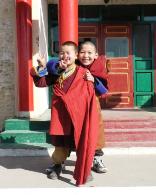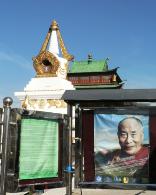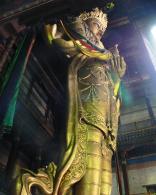


Back to City
Life in Ulan
Bator...
Life in Ulan
Bator...
Little Buddhist posing for me.
Hello, Dalai.
The tallest standing indoor Buddha.
September 30, 2006
How do I put this politely?
This city leaves a little bit to be desired.
That being said, there were a couple great things about it.
We visited the Gandan Monastery in the morning and got to watch the monks do their prayers. There is something about it that is
so wonderful to watch. We even saw some mini-monks fooling around. Or as Jeannie would say “He was being a cheeky-monkey.”
There were many temples in this monastery and I only went into a few. One of the main temples houses the tallest standing
Buddha (mark that one on your ‘fun fact’ list). Before leaving, I visited one last temple where there were little monks outside that
wanted their pictures taken. They were having so much fun looking at the camera to see what their images look liked. It was really
refreshing to see that even though their lives are based around their faith, they can still be kids and have fun and laugh and play.
After checking into our hotel (that proudly displayed advertisements for nightly stripteases with ‘Hot Girls’), Catherine and I went
to the National History museum. We were both hoping to learn a bit more about the recent history of this country. Ari had said that
the Mongolians hate the Chinese. He also said that they see the Russians as ‘their brothers’.
We learned that the Chinese invaded Mongolia (I forget the exact year but it was around 1919 as the Mongolians had only become
independent from China in 1911) and that the Bolsheviks came to Mongolia’s aide. The Communist Party soon came into power in
1921 and the Soviets helped redesign the capital city, now renamed Ulan Bator (meaning ‘Red Hero’) from its original name ‘Niislel
Khurehe’. So you can imagine what the buildings here looked like…the exact same Communist-era style buildings that can be found
in the former Soviet countries. Not a very pretty sight. The Communist Party made it illegal for the people of Mongolia to practice
Buddhism. All of the lamas had to go into the work force. In the 1930s, the Communist Party even went as far as burning down
most of the 700 monasteries and killing 14,000 monks. Once the Berlin Wall came down, that was Mongolia’s cue for a democracy.
We both came out of there with much more knowledge than we went in with. But it was time to give our brains a rest and enjoy the
Mongolian sunshine. What they call ‘the world’s coldest capital’, was looking anything but. We went to a great little European café
called ‘Chez Bernard’. The name in itself was too cute to pass up. We sat in the sun and I actually had to leave before Catherine
because I was too hot. In Mongolia. Craziness.
I was basically out of things to do in Ulan Bator. It was pure luck that I was able to get wireless access in my hotel so I could actually
get caught up on emails and researching a few things. This also provided me with time to kill before meeting back up with the group
to go to a Mongolian cultural show.
The Mongolian cultural show consisted of singers, people playing Mongolian instruments, people performing tribal dances, throat
singers (totally bizarre as they use their stomach and not their throat and the noise sounds like a cross between whistling and a
flute), contortionists, etc. With all of these different performances, I was surprised that 75 minutes never felt so long in my life.
I was happy to get back to the hotel. Catherine and I watched ‘Be Cool’ on one of the movie stations and we both got really excited
when they referenced ‘Mongolian BBQ’ and ‘Mongolia’. Sadly, I think we were both more entertained with that than with the
performance we saw earlier in the night…
How do I put this politely?
This city leaves a little bit to be desired.
That being said, there were a couple great things about it.
We visited the Gandan Monastery in the morning and got to watch the monks do their prayers. There is something about it that is
so wonderful to watch. We even saw some mini-monks fooling around. Or as Jeannie would say “He was being a cheeky-monkey.”
There were many temples in this monastery and I only went into a few. One of the main temples houses the tallest standing
Buddha (mark that one on your ‘fun fact’ list). Before leaving, I visited one last temple where there were little monks outside that
wanted their pictures taken. They were having so much fun looking at the camera to see what their images look liked. It was really
refreshing to see that even though their lives are based around their faith, they can still be kids and have fun and laugh and play.
After checking into our hotel (that proudly displayed advertisements for nightly stripteases with ‘Hot Girls’), Catherine and I went
to the National History museum. We were both hoping to learn a bit more about the recent history of this country. Ari had said that
the Mongolians hate the Chinese. He also said that they see the Russians as ‘their brothers’.
We learned that the Chinese invaded Mongolia (I forget the exact year but it was around 1919 as the Mongolians had only become
independent from China in 1911) and that the Bolsheviks came to Mongolia’s aide. The Communist Party soon came into power in
1921 and the Soviets helped redesign the capital city, now renamed Ulan Bator (meaning ‘Red Hero’) from its original name ‘Niislel
Khurehe’. So you can imagine what the buildings here looked like…the exact same Communist-era style buildings that can be found
in the former Soviet countries. Not a very pretty sight. The Communist Party made it illegal for the people of Mongolia to practice
Buddhism. All of the lamas had to go into the work force. In the 1930s, the Communist Party even went as far as burning down
most of the 700 monasteries and killing 14,000 monks. Once the Berlin Wall came down, that was Mongolia’s cue for a democracy.
We both came out of there with much more knowledge than we went in with. But it was time to give our brains a rest and enjoy the
Mongolian sunshine. What they call ‘the world’s coldest capital’, was looking anything but. We went to a great little European café
called ‘Chez Bernard’. The name in itself was too cute to pass up. We sat in the sun and I actually had to leave before Catherine
because I was too hot. In Mongolia. Craziness.
I was basically out of things to do in Ulan Bator. It was pure luck that I was able to get wireless access in my hotel so I could actually
get caught up on emails and researching a few things. This also provided me with time to kill before meeting back up with the group
to go to a Mongolian cultural show.
The Mongolian cultural show consisted of singers, people playing Mongolian instruments, people performing tribal dances, throat
singers (totally bizarre as they use their stomach and not their throat and the noise sounds like a cross between whistling and a
flute), contortionists, etc. With all of these different performances, I was surprised that 75 minutes never felt so long in my life.
I was happy to get back to the hotel. Catherine and I watched ‘Be Cool’ on one of the movie stations and we both got really excited
when they referenced ‘Mongolian BBQ’ and ‘Mongolia’. Sadly, I think we were both more entertained with that than with the
performance we saw earlier in the night…